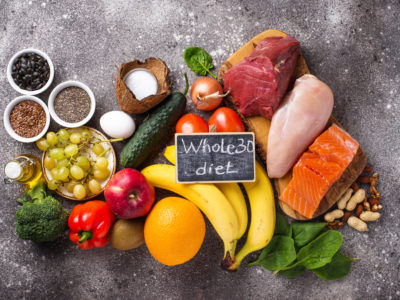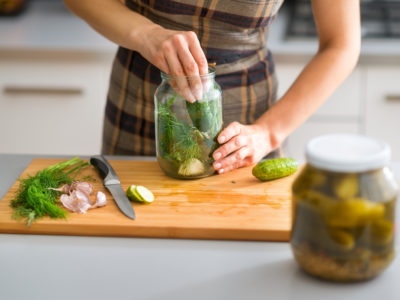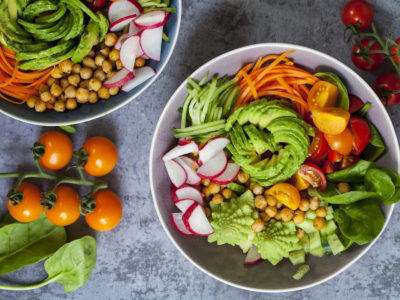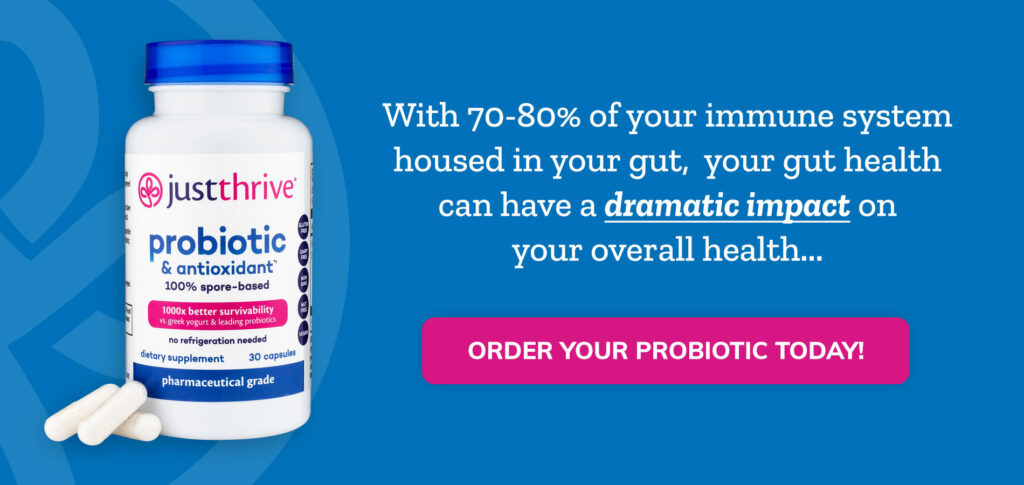Table of Contents[Hide][Show]
What is Whole30
Someone in your life is doing “Whole30” this month , and they’re likely telling everyone about it.
And if you haven’t heard anyone talking about it… then it might be you.
If you haven’t heard of it (and you weren’t listening while someone explained it to you), “Whole30” is a month-long, low carbohydrate exclusionary diet. For 30 days, you cut out soy, dairy, grains, alcohol, legumes, and added sugars.
So… probably most of what your regular Western diet consists of. The idea is that after 30 days, a participant would slowly start to introduce food groups back into their diet, so that they can see which foods may have been secretly irritating them or causing discomfort. Sort of like the idea behind the FODMAP diet for those with digestive issues. Basically, the Whole30 program differs from a standard diet in that it doesn’t just help you lose weight. It’s an elimination diet that helps you identify your food sensitivities, so that you can have better overall health.
What Effects to Expect During Whole30
People starting a Whole30 diet experience a range of positive (and sometimes negative) bodily reactions during those 30 days including sugar withdrawal, carb cravings, alcohol detox, deep sleep, and the absence of brain fog.
Whole30 participants who believe in it really throw their weight behind the diet, expounding on all kinds of benefits:
- Higher energy levels
- Weight loss
- Less bloating and constipation
- Consistently better sleep
- Less frequent bouts of illness
- Less hunger cravings
- Clearer skin
- And more!
But… While the gut microbiome (the population of good an bad bacteria living in your gut) certainly functions better without processed foods and alcohol, it truly thrives on the diversity of our diets and activities. Whole30 is, by its very nature, restrictive, not diverse. The diet calls for completely avoiding legumes, nuts, beans, grains, and dairy, which in varying doses, feed the good bacteria in your gut and assist with many digestive and immune issues.
FREE ebook
Has Your Gut Sprung a Leak?
Learn what you can do to fortify your intestinal barrier and give your gut what it needs to thrive.

However, it’s still possible to adhere to the Whole30 diet plan and maintain a happy and healthy gut.
You’ve just got to know what to eat and how to best choose your food for optimal gut and digestive impact.
So how does this diet affect the health of your gut flora and what can you eat?
Let’s investigate a bit…
What You CAN Eat
The “whole” bit of Whole30 signifies that everything allowed on the diet is exclusively unprocessed, natural, whole foods.
That means vegetables, fruits, unprocessed meats (no added sugar or preservatives), seafood, eggs, nuts and seeds, some oils and ghee, and coffee. You can still have healthy fats and proteins, but that’s it.
You’re cutting out dairy, grains, alcohol, legumes (beans, tofu, miso, edamame, soy, chickpeas, lentils, peas, and peanuts), added sugar, artificial sweeteners, MSG, sulfites, carrageenan, and junk food in general.
Now, greens and unprocessed foods are good for your gut flora. And focusing on only those foods can help to heal your gut by eating meals with only a few ingredients (so that your digestive system isn’t working overtime to process complex meals with lots of components and additives.)
Other Whole30 foods, like extra virgin coconut oil and pure coconut milk, are known for helping to fight stomach inflammation and ulcers.
But some of the guidelines on the Whole30 meal plan demand you eliminate powerful food allies.
Here’s what they are and how they help your microbiome flourish…
Related
10 Foods To Add To Your Microbiome Diet
Nourish your gut with a healthy microbiome diet. Incorporate these 10 foods into your meals starting today!
What You’re Missing
It’s important to look at Whole30 from the macro-level, and then the micro-level.
The elimination of all those food groups all at the same time bodes badly for your gut, according to Dr. Mahmoud A. Ghannoum (the guy who started using the word “microbiome” in reference to your gut’s habitat.)
He breaks down the potentially inflammatory foods that Whole30 eliminates and explains why they’re necessary for flourishing gut flora.
Grains, especially whole grains like oats, quinoa, and gluten-free options like brown and wild rice can help decrease inflammation, so removing them from your diet may actually irritate the digestive tracts of those who suffer from inflammation.
Dairy has loads of healthy proteins that feed good gut bacteria, although he agrees dairy should be consumed in moderation.
Legumes and soy foods, like beans, lentils, and dried peas are consistently praised for their gut benefits. They are heavy in soluble and insoluble fiber, which not only keep the bowels running smoothly but also feed the positive bacteria in your intestines.
Whole30-believers claim they cut out legumes because of their phytate content. Phytate is an element that blocks absorption of nutrients—but they’re contained in meat as well. And as it turns out, cutting out legumes doesn’t cut out phytates.
Now, Whole30’s elimination experiment isn’t a bad plan—but for the purposes of gut health, it’s flawed.
Cutting out legumes, grains, and dairy all at once, when they’re helpful and healthful for your gut bacteria, isn’t necessarily advisable.
Cutting out one group at a time, and charting your body’s reaction, would allow for a still-thriving digestive system and an informative hypothesis testing.
If you already experience gut issues and you’re considering a restrictive diet, you should always consult your doctor first.
What Are Some Meals You Can Eat on Whole30
If you still want to move forward with Whole30, you might be wondering what kinds of meals you can make during this time.
From a 30,000 foot level, you want the meals you make to be as simple as possible—fewer ingredients means your gut has an easier time breaking down what you’ve given it. When you overload your plate with complicated and layered meals, the gut has to work extra hard to scour through the food for nutrients.
You also want to focus as much as possible on green veggies, particularly cruciferous kinds. Don’t try to make fake-versions of your favorite treats with excessively complicated recipes or meals with ingredients far-removed from their original form. For example, avoid cauliflower-pizza crusts with vegan cheese to remind yourself about pizza.
You definitely want to get as much fermented food in as you can to make up for the lack of legumes and grains. Try incorporating sauerkraut, specific vitamin supplements, kombucha, unsweetened coconut milk yogurt—any of those will do fine!—into your daily diet.
Related
Improve Your Health With Fermented Food
Learn more about the benefits of fermented foods, some do’s and don’ts, and what some of the most popular fermented foods are.
But we can even get a little more specific…
Let’s talk recipes that are not only healing for the gut, but Whole30 approved.
Chicken Korma with Cauliflower Rice
Chicken Marinade Ingredients
- 2 lbs skinless chicken thighs, chopped into bite-size pieces
- 1 cup full-fat canned coconut milk
- 1 tbsp lemon juice
- ½ tsp garam masala, ground coriander, turmeric, paprika, sea salt, and fresh black pepper
Sauce Ingredients
- 4 tbsp grass-fed ghee
- 1 large yellow onion, peeled and diced
- 8 garlic cloves, minced
- 1 tsp ginger, minced
- 1 ½ garam masala
- 1 ½ ground coriander
- 1 tsp sea salt
- ½ ground mustard seed powder
- 1 red bell pepper, cored and diced
- 15 oz tomato sauce
- 1 can full-fat canned coconut milk
- 1 cup organic, grass fed bone broth
Cauliflower Rice Ingredients
- 1 head of cauliflower, florets chopped and stems removed
- 2 tbsp avocado oil
- 4 cloves minced garlic
- 1 tsp sea salt
Instructions
- Combine chicken marinade and add chicken thighs. Cover and leave in the fridge for at least 2 hours.
- After 2 hours, melt 2 tbsp ghee in a pot over medium heat. Add diced onions and cook for 10 minutes. Then add ginger and garlic. Saute for another 2 minutes. Add all spices and saute for another 2 minutes.
- Add chicken thigh meat with the marinade and cook for 5-10 minutes.
- Add bell pepper, tomato sauce, coconut milk, and bone broth, and let it bubble for a half hour.
- Add the cauliflower florets to a food processor and pulse until it’s riced. Fry it with avocado oil, garlic, and spices, for 20 minutes.
- When the korma is done, add the last 2 tbsp of ghee and pour the korma over cauliflower rice.
Done!
Double the recipe and eat it all week long.
You see, the bone broth, cauliflower rice, and ghee as a substitution for butter nourish your gut while strictly aligning with Whole30’s rules and requirements.
This is certainly not the only recipe that’s both Whole30 and gut health compliant.
If you’re ready for more options go here for more Whole30 recipes you can try.
Closing Thoughts
The Whole30 plan promotes healthy eating by encouraging people to eat whole, unprocessed foods while eliminating foods that may be causing health issues. The goal is to find out which foods are hurting your health by process of elimination so that you can cut those specific foods.
By the end of 30 days, you begin the reintroduction of foods that haven’t been causing any health problems.
However, according to many health experts, even during the 30 days, it’s not a good idea for your health to cut foods that aren’t Whole30 approved such as certain grains and legumes because they have important nutrients needed for the digestive and immune systems.
There are plenty of benefits to the Whole30 diet, but ask your healthcare professional or nutritionist first if it’s a good idea for you. The best plan for your overall health is one that fits your specific needs and lifestyle.
Editor’s Note: This post was originally published on January 9, 2020, and has been updated for quality and relevancy on September 27, 2021.







